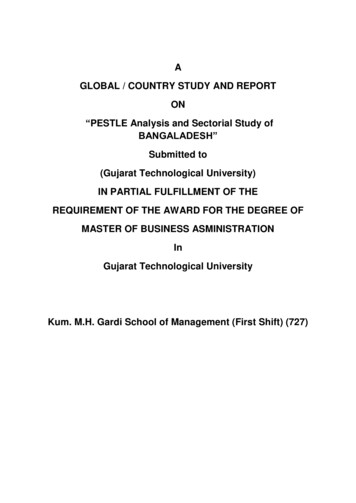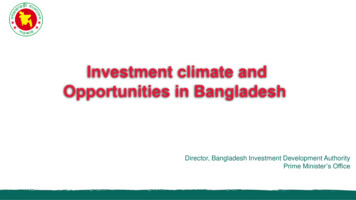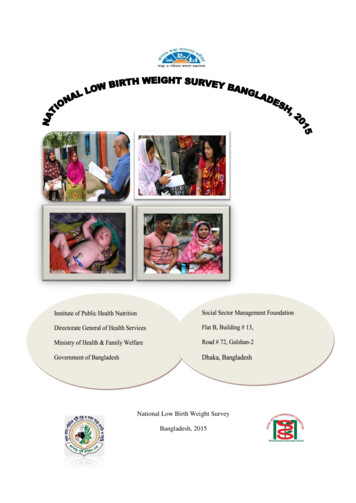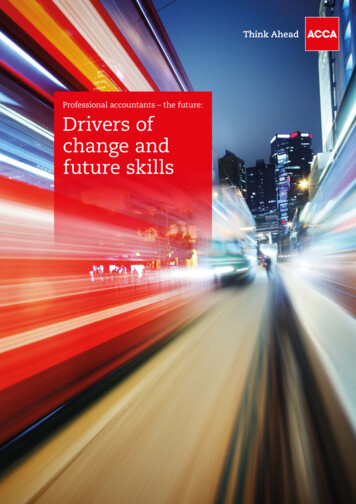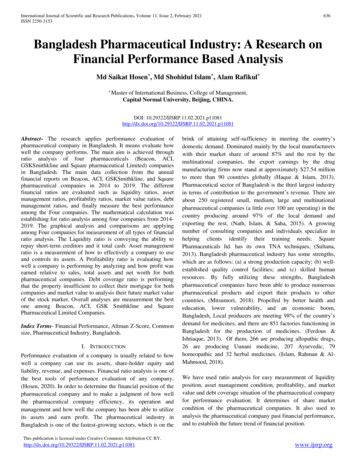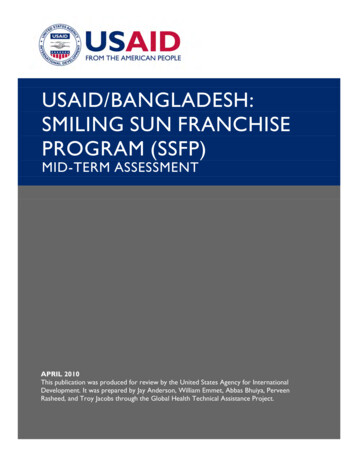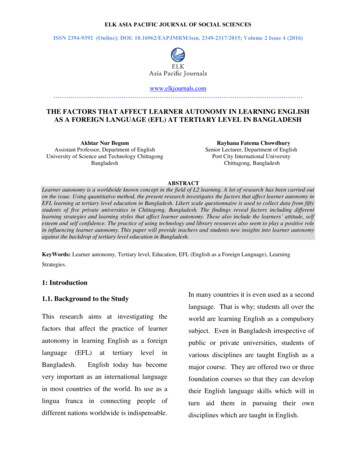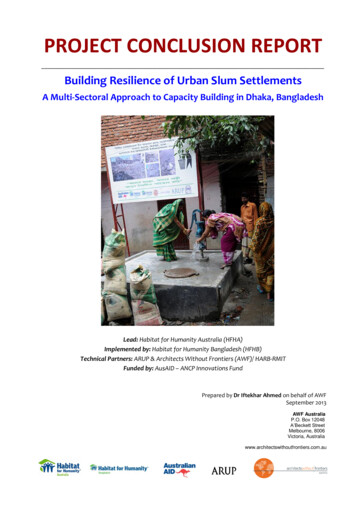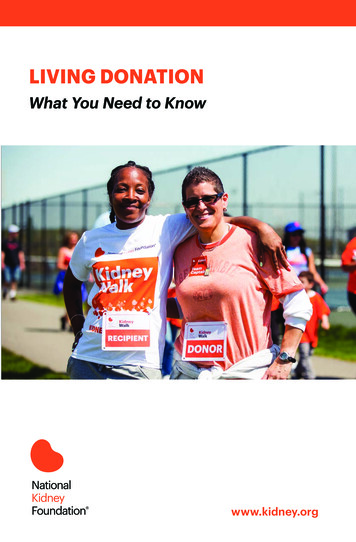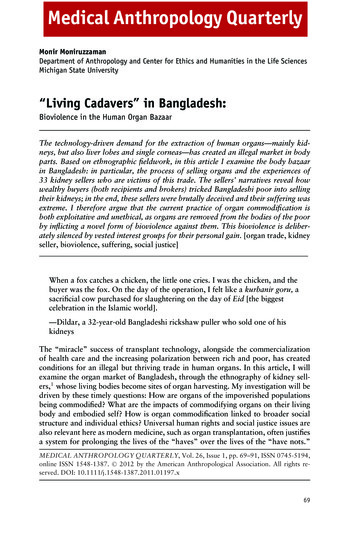
Transcription
Monir MoniruzzamanDepartment of Anthropology and Center for Ethics and Humanities in the Life SciencesMichigan State University“Living Cadavers” in Bangladesh:Bioviolence in the Human Organ BazaarThe technology-driven demand for the extraction of human organs—mainly kidneys, but also liver lobes and single corneas—has created an illegal market in bodyparts. Based on ethnographic fieldwork, in this article I examine the body bazaarin Bangladesh: in particular, the process of selling organs and the experiences of33 kidney sellers who are victims of this trade. The sellers’ narratives reveal howwealthy buyers (both recipients and brokers) tricked Bangladeshi poor into sellingtheir kidneys; in the end, these sellers were brutally deceived and their suffering wasextreme. I therefore argue that the current practice of organ commodification isboth exploitative and unethical, as organs are removed from the bodies of the poorby inflicting a novel form of bioviolence against them. This bioviolence is deliberately silenced by vested interest groups for their personal gain. [organ trade, kidneyseller, bioviolence, suffering, social justice]When a fox catches a chicken, the little one cries. I was the chicken, and thebuyer was the fox. On the day of the operation, I felt like a kurbanir goru, asacrificial cow purchased for slaughtering on the day of Eid [the biggestcelebration in the Islamic world].—Dildar, a 32-year-old Bangladeshi rickshaw puller who sold one of hiskidneysThe “miracle” success of transplant technology, alongside the commercializationof health care and the increasing polarization between rich and poor, has createdconditions for an illegal but thriving trade in human organs. In this article, I willexamine the organ market of Bangladesh, through the ethnography of kidney sellers,1 whose living bodies become sites of organ harvesting. My investigation will bedriven by these timely questions: How are organs of the impoverished populationsbeing commodified? What are the impacts of commodifying organs on their livingbody and embodied self? How is organ commodification linked to broader socialstructure and individual ethics? Universal human rights and social justice issues arealso relevant here as modern medicine, such as organ transplantation, often justifiesa system for prolonging the lives of the “haves” over the lives of the “have nots.”MEDICAL ANTHROPOLOGY QUARTERLY, Vol. 26, Issue 1, pp. 69–91, ISSN 0745-5194,C 2012 by the American Anthropological Association. All rights reonline ISSN 1548-1387. served. DOI: 10.1111/j.1548-1387.2011.01197.x69
70Medical Anthropology QuarterlyI will argue that organ commodification is seriously exploitative and ethically reprehensible, as organs are extracted from the bodies of the poor by inflicting a novelform of bioviolence against them.The People’s Republic of Bangladesh is an emerging organ bazaar that has beenin existence for more than a decade. It is tacitly endorsed by national media thatopenly publish newspaper classifieds seeking kidneys, livers, corneas, and any othertransplantable part of the human body. Every day, organ classifieds reach millionsof poor rickshaw pullers, day laborers, slum dwellers, and village farmers, some ofwhom eventually sell their body parts to try to get out of poverty. The recipients areeither local or overseas residents (almost all of them are Bangladeshi-born foreignnationals) who purchase organs within Bangladesh and then obtain their transplantsurgery mostly in India, as well as in Bangladesh, Thailand, and Singapore.2 Amidthis trading, a number of organ brokers have expanded their network and run thebusiness for a hefty fee. Medical specialists also benefit from this illegal exchange. In1999, the Bangladeshi Parliament passed the Organ Transplant Act, which imposesa ban on trading body parts and publishing any related classifieds. The Act explicitlystates that anyone violating this law could be imprisoned for a minimum of threeyears to a maximum of seven years and penalized with a minimum fine of 300,000Taka ( 4,300; see Bangladesh Gazette 1999:1819). Nonetheless, the organ trade isgrowing in Bangladesh, a country where 78 percent of its inhabitants live on lessthan 2 a day, not to mention it virtually has no cadaveric organ donation programuntil today. The average quoted price of a Bangladeshi kidney is currently 100,000Taka ( 1,400)—a figure that has gradually dropped because of the abundant supplyof body parts from the poor majority.The market of human organs is recurrently theorized as both a global-economicand a macro-ethical phenomenon, as it is embedded in a larger system of exchangeand extraction across differences of wealth and encompasses the broad dynamics ofboth the developed and developing worlds. The historical relationship of conquest,colonization, and extraction has shaped the transformation of actual Third Worldbodies into raw materials in their own right. The outcome is a serious form ofexploitation of the Third World, where impoverished populations become organsuppliers to prolong lives for the Western few. Predominantly, the global organtrafficking analyzed through the East–West dichotomy is the focus of our ongoing investigation. As Nancy Scheper-Hughes notes, the flow of organs follows themodern route of capital: from South to North, from Third to First World, frompoor to rich, from black and brown to white, and from female to male (2000:193).Shimazono also identifies that the most common way to participate in organ trafficking is through “medical tourism,” in which potential recipients travel abroad toundergo organ transplant and buy organs from the host country (e.g., Japanese recipients receive transplants from Chinese prisoners in China). In addition, there arereported cases of living sellers of different nationalities being brought to recipients’countries for transplant surgery (e.g., a Moldavian seller to an American recipientor a Nepalese seller to an Indian recipient). In other cases, recipients and sellersfrom two different countries travel to a third country for transplant surgery (e.g., anIsraeli recipient and an Eastern European seller travel to South Africa [Shimazono2007:956–957]; see also Scheper-Hughes 2005:26).
Bioviolence in the Human Organ Bazaar71In contrast, my research focuses on domestic organ trafficking that is operatingat national, regional, and international levels. In Bangladesh, the common scenario of organ trafficking is that local recipients (almost all of whom are wealthy)find organ sellers within their own country and travel abroad to undergo organtransplant (i.e., both recipients and sellers are Bangladeshis who travel abroad,mostly to India, for transplantation). In some cases, both recipients (mostly middleclass people) and sellers are from Bangladesh; they receive organ transplants withinBangladesh (i.e., Bangladeshis sell to Bangladeshi recipients, and their transplantsare performed in Bangladesh). In a very few cases, Bangladeshi recipients (wealthypeople) travel abroad for organ transplant and buy organs from the host country (e.g., Bangladeshi recipients receive organs from Pakistani sellers in Pakistan).In other cases, international recipients (mostly Bangladeshi-born foreign nationals) find sellers in Bangladesh and travel abroad to undergo organ transplant (e.g.,North American, European, or Middle Eastern recipients and Bangladeshi sellerstravel abroad for transplantation). Domestic organ trade, which perhaps comprisesthe majority of organs being trafficked worldwide, also ought to be examined indepth, as opposed to global organ trafficking on a broader spectrum.Organ trade also needs to be explored through the ethnography of kidney sellers,as they offer subaltern voices against the dominant discourse. However, only halfa dozen succinct ethnographies and research reports on kidney sellers in particularhave been published to date (Budiani-Saberi and Delmonico 2008; Goyal et al. 2002;Moazam et al. 2009; Naqvi et al. 2007, 2008; Scheper-Hughes 2003a; Zargooshi2001a, 2001b); none of them reveals the detailed processes and experiences of sellingorgans, as well as the broader ramifications of this trade.Further, no rigorous longitudinal study among kidney sellers exists to date.Even though a few long-term studies on living kidney donors have been publishedrecently (El-Agroudy et al. 2007; Ibrahim et al. 2009), they focus mostly on thephysical impacts of the procedure (Bruzzone and Berloco 2007:1785; Danovitch2008:1361; Davis and Delmonico 2005:2103), and are based on data from kidneydonors who are mainly from developed countries. In contrast, my ethnographydemonstrates that selling kidneys causes serious physical, psychological, social, andeconomic harm to kidney sellers.Medical anthropologists have contributed centrally to the scholarly discussionon organ trafficking. They strongly oppose commodifying body parts, arguing thatthis practice purportedly capitalizes on the distress of those in need, particularlybecause, as the poor can participate in such a system only as organ sellers, it is anexploitative practice. As Scheper-Hughes concludes, the grotesque niche market fororgans has created a kind of “medical apartheid that has divided the world intoorgan buyers and organ sellers and created a medical, social, and moral tragedyof immense and not yet fully recognized propositions” (2003b:1648). Similarly,Lawrence Cohen argues, in the ethical realm of organ transplant, advancement ofexpensive biotechnology and commercialization of health care becomes increasinglysynonymous, while options for life-saving treatment for the poor are unimaginable(Cohen 1999:149; see also Sanal 2004). Anthropologists also argue that certainliving things should not be alienable for commercialization, as such a practice iscarried out against culture and humanism in general (see also Fox and Swazey1992; Joralemon 2001; Sharp 2000; Tober 2007).
72Medical Anthropology QuarterlyAlthough organ trafficking is critically analyzed by medical anthropologists, theviolence—what I prefer to term bioviolence—for procuring “fresh” organs from asubset of the population has yet to be examined. I consider bioviolence a blend ofphysical, structural, and symbolic violence, all of which are carried out to extractorgans from the oppressed bodies of the poor. Margaret Lock (2000) addresses thesymbolic violence, particularly in cadaveric organ procurement, elaborating howthe transplant industry creates an insatiable demand for organs, which will, as sheargues, always remain greater than the supply because the medical eligibility toreceive an organ grows even more acute (see also Illich 1976; Koch 2002; ScheperHughes 2003a; Sharp 2006). At the same time, the industry studiously ignores thesource of harvested organs almost all the time. Lock therefore underscores that thisartificially created organ scarcity and the procuring of organs from every sourcegenerate unavoidable violence, which flourishes in every aspect of the transplant enterprise, but has been largely masked by powerful rhetoric associated with “the giftof life.” According to Lock, this constitutes symbolic violence, as it folds seamlesslyinto the institutional setting, appears as a natural phenomenon for daily life, andbecomes normalized through the rhetoric of scientific progress (Lock 2000:291). Inthis article, I examine the bioviolence against the living poor, whose kidneys arebeing extracted in the underground organ bazaar of Bangladesh.What is Bioviolence?Bioviolence is an instrument to transform human bodies, either living or dead,either whole or in parts, as sites of diverse exploitation viable through new medicaltechnologies. In essence, bioviolence is an act of inflicting harm and intentionalmanipulation to exploit certain bodies as a means to an end. This term not onlyrefers to the act itself (i.e., extracting organs from the physical body) but also tothe processes involved (i.e., deception and manipulation for organ procurement) inthe exploitation of bodies, mostly of impoverished populations. Bioviolence is thebyproduct of technological experimentation and a vehicle for structural exploitationto fulfill the medical need and desire of the affluent few, but at the cost of bodily harmto the deprived majority. For example, the recent advancement of biotechnology hasfragmented the human body into 150 reusable parts, such as organs, tissues, sperm,and blood (Hedges and Gaines 2000) to alter, increase performance of, and prolongthe bodies of the privileged minority. However, these “spare parts” are removedalmost exclusively from the poor by inflicting bioviolence against them. Similarly,assisted reproductive technology (i.e., in vitro fertilization) has produced anotherform of bioviolence, whereby a poor woman reluctantly carries and delivers a childfor a wealthy infertile couple, but at the expenses of her own physical health. Herethe body of the surrogate mother is intact, as opposed to the organ trade, where thebody of the kidney seller is fragmented. In a similar way, biopiracy refers to anotherform of bioviolence, through which the dominant class or developed countriesare patenting biological resources, such as genetic cell lines or plant substances ofthe marginalized populations or developing nations without fair compensation oragreement. For instance, the immortal HeLa cell was taken from Henrietta Lacks’sbody without her consent and has been commercially used in numerous scientificresearch studies, such as for cancer, polio, AIDS, and gene mapping, for more than
Bioviolence in the Human Organ Bazaar73half a century (Skloot 2010). While in clinical drug trails, the bodies, again mostlybodies of the poor, are subject to medical experimentation, often through improperconsent and deceptive promises. At the end, they are deliberately left untreated; thisentire process and dynamic constitutes another form of bioviolence. Bioviolence isan important analytical tool to examine the exploitation of the poor, elapsing onthe margin of “other cultures,” but at the target of emerging medical technologies.To examine bioviolence, particularly in the organ bazaar of Bangladesh, it isessential to synthesize the structural processes and individual agency, as opposedto focusing on one aspect to the exclusion of the other. I will therefore explorehow bioviolence is carried out to extract organs from the living poor. How it isrationalized but kept silent in a particular setting? Does it contradict the principlesof social justice and human rights? In addition, I will elaborate on what are themedical, social, and economic ramifications of bioviolence. To what extent canbioviolence be determined through victim’s suffering? And does bioviolence destroytheir homeostatic balance of body and self? These questions will allow me to explainbioviolence in the context of the Bangladeshi state, national media, health specialists,and organ buyers (both recipients and brokers), as well as complicate this accountwith the agency of kidney sellers, all of whom sustain this trade.To analyze the bioviolence, my ethnography documents through the lens of thevictims how the poor typically sell their kidneys to wealthy recipients. What are thelived realities that these sellers experience after selling their body parts? And, dothey support or resist organ trading in the postvending period?Exploring the processes and magnitudes of bioviolence, in this article I will elaborate how transplant recipients prolong lives, organ brokers flourish, and medicalspecialists profit at the crossroads of the neoliberal state, the commercialization ofhealthcare, and grinding poverty that intersect with the violation of justice to impoverished populations, turning them into “living cadavers.” I will argue that a grossbioviolence is routinely carried out to extract organs from their bodies; however, itis deliberately concealed to protect personal interests and is justified by individualethics.Fieldwork in a Black MarketConducting fieldwork in the illegal market of human organs is often demanding,both ethically and methodologically. Scheper-Hughes addresses how she investigated organ trafficking by conducting “undercover” research in numerous sites—from the impoverished shantytowns of the Third World to the privileged and technologically sophisticated medical centers of the First World (2004:32). ScheperHughes’s ethnographic method was “to follow the bodies”—what George Marcusformerly describes as “follow the things” (1995:107). However, one of the critiquesof this approach is that following things leads followers away from the unique perspectives of the locals who experience things removed from them (Walsh 2004:226).The question is, then, how can we deeply delve into the local details by offeringfleeting glimpses of ethnographic data from a vast number of research settings?Accordingly, I did not follow the methods of a large-scale, multisited ethnographybut chose to explore a localized ethnography on the organ trade.
74Medical Anthropology QuarterlyI faced difficulties, particularly in gaining access to kidney sellers, as they areinvolved secretly in the underground organ bazaar of Bangladesh. Most sellers donot disclose their actions to anyone—not even to spouses or siblings—as the organtrade is outlawed and is considered a disgraceful and humiliating act there. Yet,I successfully interviewed 33 kidney sellers (30 male and three female), but onlyafter gaining the trust of Dalal, an organ broker who became my key informant andintermediary of this research. To locate kidney sellers after all of my initial attempts(i.e., contacting doctors, recipients, and journalists) failed, I had no alternative butto contact an organ broker, who is connected to them like a spiderweb.3 I introduced myself to Dalal, stating that I was neither an undercover police officer nora journalist, but a “harmless” researcher. My local family background, universityteaching in Bangladesh, institutional affiliation abroad, and my partner’s identity asbedeshi (foreigner) played an essential role in gaining Dalal’s trust, while my familiarity with the Bengali language aided me in sharing my thoughts and determiningmy initial approach to Dalal without any confusion.My rapport with Dalal raises an ethical challenge: how researchers gain accessto “hidden populations,” especially when the key informant is engaged in criminalactivities and is exploiting research subjects. As my research would have not beenpossible without the support of Dalal, I consider that a key informant techniqueis effective in gaining access to “hidden populations” (see Bourgois 2003; Whyte1981). The question, however, is how a researcher can negotiate with such key informant. I maintain a methodologically effective approach without impeding ethicalintegrity. For example, while Dalal assumed that he would receive lofty monetarybenefits, I reimbursed him only for his transportation and communications costs(on average, 500 Taka, equivalent to 7) for each seller. Or, when Dalal demandedthat I include his photos and contact address in my “English publication,” assuming that this would disseminate his business abroad, I refused his plea, arguing thathaving his identity revealed could bring him serious troubles. My point here is thatthe researcher needs to persuade the key informant persistently, unhurriedly, andethically to gain access to invisible populations (as opposed to large-scale, multisitedethnography, in which the researcher may approach hastily or conceal his or herpersonal identity to obtain data quickly).My fieldwork was carried out in Dhaka, the capital of Bangladesh, and wasconducted mainly in 2005. While “hanging out” in the field, I introduced myselfas former professor in a Bangladeshi university and doctoral candidate in a Canadian university to gain access to various groups, that is, nephrologists, urologists,and postgraduate trainees, as well as recipients, their families, and their organization, Bangladesh Kidney Patients’ Welfare Association, along with brokers, lawyers,journalists, and members of a private body donation group. To conduct researchat Bangabandhu Sheikh Mujib Medical University Hospital, the major center fororgan transplants in that country, I attained permission from the head of the Department of Nephrology after submitting my written application. I also obtainedapproval from the Ethics Review Board at the University of Toronto to conductthis research. Predominantly, I used in-depth interviews with kidney sellers, as wellas informal discussions with other groups, to collect my data. I also employedparticipant-observation, focus group discussion, and case study method. I spent anaverage of ten hours with each kidney seller. All interviews were unstructured andnarrative based.
Bioviolence in the Human Organ Bazaar75The Labyrinth of BioviolenceThirty-three Bangladeshi kidney sellers—all of whom are poor—document the bioviolence inflicted on them to procure organs from their bodies. Through this “processual ethnography,” they outline the processes and experiences of commodifyingkidneys, and from which they suffer severely afterward. In this section, I revealthe various stages of kidney selling, describing how sellers are entrapped, meetwith a broker, obtain fake passports, travel abroad for the surgery, and return toBangladesh with a permanent scar and extreme suffering. This ethnographic account addresses how the bioviolence against kidney sellers is being individualizedand contextualized. Their odyssey for selling their kidneys is characterized intothree sections: hope—the preoperative, sacrifice—the operative, and suffering—thepostoperative.Hope for a Better Life: The Preoperative PeriodPoverty forced my research participants to sell one of their body parts. When theseimpoverished populations come across newspaper advertisements seeking a kidneydonor, they are tempted to “donate” because of the lucrative offers (i.e., monetaryreward, job offer, or overseas visa) made in return for their kidney. Of the 1,288organ classifieds I collected, Figure 1 provides an example of an advertisementposted by a potential recipient.4In this advertisement, the recipient is very likely making false promises, as shecannot guarantee the seller’s visa abroad.The interviewed sellers have very limited knowledge about organs in the humanbody. As Mofiz, a 43-year-old tea stall owner and kidney seller, mentioned: “I sawan ad looking for the kidney posted in the daily Ittefaq in 2000. I asked one of myfriends, what is a kidney? Where is it located? What does one need to do when itis damaged? How can you donate your kidney? How much money can I get? I didnot know that a kidney could be sold for money.” All sellers hope that by sellingtheir kidneys, the wheel of their fate will turn in their favor, but they also fear thelife-threatening consequences of the surgery. The sellers eventually start gamblingbetween hope and fear.Curious about the newspaper classifieds, sellers contact the potential buyers,who are either recipients or brokers.5 The interviewed sellers reported to me thatthe recipients attempt to convince them by portraying “kidney donation” as a“noble act” that saves lives and does not harm the donor. The recipients promise tobear all the expenses and compensate the “donors” well. Most sellers also revealedthat brokers encourage them to participate in the trade by repeatedly telling a storyabout the sleeping kidney.6 The story goes like this: A person has two kidneys:one works and the other one sleeps. If one kidney is infected, the other kidneyautomatically starts working. But if one kidney is damaged, the other one will bedamaged, too, because of the polluted blood. Therefore, everyone can be healthywith only one kidney. During the operation, the doctor first starts a donor’s sleepingkidney with medicine. The “newly awakened” kidney stays in the donor’s body andthe “old” kidney is removed and given to the transplant recipient. In this manner,selling a kidney is presented as a win–win situation. The sleeping kidney story is
76Medical Anthropology QuarterlyFigure 1. The Daily Ittefaq, 4 January 2000.Translation:Request for Kidney DonationBoth kidneys of a USA resident, Kulsum Begum, are damaged. Kidney specialistsadvise her to transplant a kidney immediately. A heartfelt request is made to thegood persons who can donate a kidney with the following criteria.1. The interested donor’s blood group and the tissue must be matched with thoseof Kulsum Begum. Blood group O .2. The donor (male or female) must travel to the donation. The transplant will beperformed at [a U.S. university] medical center.3. The donor must be in good health and between 19 and 40 years of age.All the relevant expenses will be covered by Kulsum Begum. To discuss details,contact urgently the following address.Md Iman Ali, House B-12/7, Agargoan Taltala Government QuarterSher-E-Bangla Nagar, Dhaka – 1207, Telephone: 8125959.widely circulated in Bangladesh, which reflects how poor citizens are deceptivelymanipulated, a common thread of the bioviolence carried out for the purpose oforgan extraction from their bodies.Once persuaded, the buyers match blood groups and arrange tissue typing forthe sellers. Matching tissue is very difficult, which partly explains the role of abroker. When the broker successfully matches tissues, and the sellers are medically fit, the buyers bargain over the payment. They initially offer the sellers only80,000 Taka ( 1,150) for a kidney, arguing that the market value of their organsis low because their blood types are in ready supply. After further negotiations,the buyers finally agree to pay 100,000 Taka ( 1,400). However, they warn thatthe entire amount will be given to the seller just before they enter the operatingroom, as the sellers might run away with the money without relinquishing theirkidneys.
Bioviolence in the Human Organ Bazaar77Many sellers are not pleased; the buyers promise to offer them a job, arrange avisa and citizenship they will need for going abroad, or allocate land. All sellers arefearful; the buyers guarantee that the operation is 100 percent safe, saying that thesellers will be in the hands of world-renowned specialists. The buyers also mentionthat going aboard (particularly to India, where most of the transplantations forBangladeshi sellers were performed) will be fun, as the sellers can visit new places,eat out, shop, and watch Indian movies. Thus, buyers lure potential sellers throughtrickery, lying, and false promises, other widespread elements of bioviolence in theorgan bazaar of Bangladesh and beyond.The broker arranges sellers’ fake passports and forged legal documents thatindicate that the person is donating a kidney to his or her kin and advises the sellernot to disclose his or her true identity lest the Indian healthcare personnel reject thecase.7 To establish this newly commodified kin relationship, Hiru, a 38-year-oldHindu seller, underwent circumcision because his recipient was Muslim. When therecipient asked Hiru to get circumcised, Hiru agreed to do so, hoping that selling akidney would change his social sanding:When we are finalizing the trip to India, the recipients told me that we aregoing to India as “brothers.” He continued, “But brother, you are Hindu,and I am Muslim. We would not be able to complete the deal as Indiandoctors could reveal our fake identities, especially during the operation whilewe would be lying naked. The doctors would find out that I am circumcisedbut you are not.” He therefore proposed to cut off the foreskin from mysonar matha (the head of the penis), his only solution to resolve this problem.What an unbelievable crisis I faced! I could not step back from the deal, butneeded to circumcise against my religious decree. Regretfully, I asked therecipients to arrange the circumcision at Dhaka, but he told me to handle itin my village. The next morning, I went to a doctor, but due to the high costinvolved I ended up at a hazam, a local practitioner of my village. The hazamtold me that circumcision is an easy matter. He injected a medicine [localanaesthesia] in the skin of my sonar matha. He rubbed the surrounding skinand asked whether I was feeling any pain. He told me to look up at the roofand it was quickly done. I did not feel any pain, so I went to the market andcalled the recipient; he was relieved. When I was coming back home, theanaesthesia stopped working, and I felt like it was a nightmare.In the post-transplant phase, Hiru was deeply worried, believing that God wouldnot forgive him for his reckless action, as well as for not returning his body intact.Hiru’s case documents how organ buyers materialize bioviolence at any cost, evenviolating kidney sellers’ religious faith.Separation, Sacrifice, and the Rough Cut: The Operative StageAfter crossing the Indian border, buyers seize the sellers’ passports, ensuring thatthe sellers cannot return to Bangladesh until their kidneys are removed. Followingthe buyers’ instruction, the sellers stay in terrible accommodations, rooming with
78Medical Anthropology Quarterlyas many as 10 other sellers in a tiny bachelor apartment permanently rented bya broker. All the medical tests need to be redone, as the Indian doctors do notaccept the Bangladeshi results. The sellers begin to feel isolated, as they are notallowed frequent trips outside. In this bioviolence, the buyers gradually establishtheir authority, while the sellers turn into their passive agents abroad.If some sellers confront the buyers’ bioviolence, they also face threats and warningabout dismissal from this trade. However, some sellers demand an increase in theirshare after discovering that the broker is making a high profit of about 400,000 Taka( 5,500). The broker tries to explain the huge expenses and high risks involved inthis murky business. Sodrul, a 22-year-old c
conditions for an illegal but thriving trade in human organs. In this article, I will examine the organ market of Bangladesh, through the ethnography of kidney sell-ers,1 whose living bodies b
